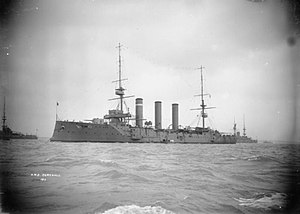HMS Cornwall (1902)

| |
| History | |
|---|---|
| Name | HMS Cornwall |
| Builder | Pembroke Dock |
| Laid down | 11 March 1901 |
| Launched | 29 October 1902 |
| Fate | Sold 7 July 1920 |
| General characteristics | |
| Displacement | 9,800 tons |
| Length | 463.5 ft (141.3 m) |
| Beam | 66 ft (20.1 m) |
| Draught | 25 ft (7.6 m) |
| Propulsion | list error: <br /> list (help) 4-cylinder triple-extension steam engines two shafts 31 Babcock boilers 22,000hp |
| Speed | apprx 23 knots |
| Complement | 678 |
| Armament | list error: <br /> list (help) 14 x BL 6-inch (152.4 mm) Mk VII guns 9 x 12 pounder guns |
| Armour | list error: <br /> list (help) 4in (102mm) belt 5in (127mm) barbette 5in (127mm) turret |
HMS Cornwall was a 9,800 ton Template:Sclass- armoured cruiser of the Royal Navy.
She was laid down at Pembroke Dock 11 March 1901,[1] launched in 1902, and commissioned in 1904.
On August 6, 1911 the Cornwall ran aground on Pinnacle Rock, off Cape Sable Island (Nova Scotia). At the time, she was assisting HMCS Niobe, which had also run aground. Both cruisers were refloated.[2]
On the outbreak of World War I in 1914 she was dispatched to West Africa to intercept German merchant shipping. She then proceeded to the Falkland Islands in the squadron commanded by Vice-Admiral Doveton Sturdee, consisting of the battlecruisers Inflexible and Invincible, the pre-dreadnought battleship Canopus, two armoured cruisers, three light cruisers and one armed merchant cruiser.
On 8 December 1914 Sturdee's squadron encountered a German squadron commanded by Vice-Admiral Maximilian von Spee, consisting of the heavy cruisers Scharnhorst and Gneisenau together with the light cruisers Nürnberg, Leipzig and Dresden.
In the ensuing battle of the Falkland Islands, Cornwall assisted in the sinking of Leipzig. Of the five ships of the Kaiserliche Marine, only Dresden escaped.
Following the battle, Cornwall returned to West Africa. In June 1915 she was sent to support the Dardanelles Campaign.
In October 1916 she was sent to the East Indies and China Stations to protect Allied shipping from surface raiders. She returned to the United Kingdom in 1917 where she was refitted. For the remainder of the war she escorted convoys between Canada and the UK.
She paid off early in 1919 and was scrapped in 1920.
References
- ^ "Naval & Military intelligence". The Times. No. 36403. London. 15 March 1901. p. 4. template uses deprecated parameter(s) (help)
- ^ "Monmouth class cruisers". Battleships-Cruisers.co.uk. Cranston Fine Arts. 2001 - 2008. Retrieved 2008-07-01.
{{cite web}}: Check date values in:|date=(help); Cite has empty unknown parameter:|coauthors=(help)
- Colledge, J. J.; Warlow, Ben (2006) [1969]. Ships of the Royal Navy: The Complete Record of all Fighting Ships of the Royal Navy (Rev. ed.). London: Chatham Publishing. ISBN 978-1-86176-281-8.
